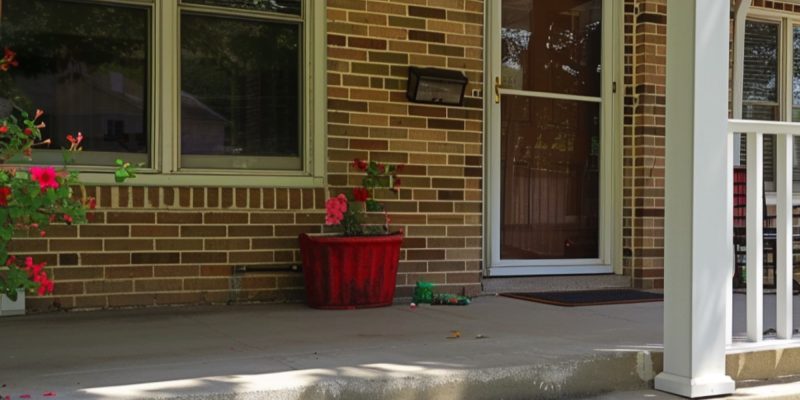Are you looking to give your concrete porch a facelift? Adding a wooden deck overlay can transform your outdoor space into a cozy, inviting area for your family and friends. This guide will walk you through everything from assessing your current porch to the final touches of maintenance, ensuring your project is a success from start to finish.
Assessing the Concrete Porch
Before you start dreaming about your new wooden deck, it’s important to take a close look at your existing concrete porch. Here’s how:
Understanding Structural Soundness
Check your porch for any large cracks or areas where the concrete seems to be sinking. Small hairline cracks are typically okay, but if you find bigger issues, it might be time to call in a professional for advice. The key here is making sure the concrete is strong enough to support your new deck.
Importance of a Level Surface
Use a long level to see if your porch is flat. If it’s mostly level with only slight slopes for water drainage, you’re good to go. A flat surface will make your deck installation smoother and ensure it’s safe to use.
By taking the time to properly assess your concrete porch, you’ll save yourself a lot of trouble during the deck installation process.
Preparing for Deck Installation
Getting ready for your deck project involves a bit more than just gathering tools. Here’s what you need to do:
Legal and Safety Considerations
Des Moines residents should check with local building codes and obtain any necessary permits before starting the project. This ensures your deck is up to standard and avoids any legal headaches down the road.
Tools and Supplies Needed
Gather your tools and materials ahead of time. Essential tools include a drill, saw, level, tape measure, and materials like wood or composite decking, screws, and concrete anchors. Having everything on hand will make the process go much smoother.
TIP
Preparation is key to a successful deck project. By covering your legal bases and organizing your tools and materials, you’re setting yourself up for a smooth installation.
Designing the Layout
Creating a plan for your deck is like drawing a map before a trip. It guides you on where to go and helps avoid surprises. Here’s how to start:
Visualizing the Finished Project
Picture how you want your deck to look. Drawing your ideas on paper can help you see what will work best for your space and what won’t.
Functionality and Aesthetics
Think about how you’ll use your deck. Also, consider how the deck will look with your house. You want it to feel like it’s always been there, not just added on.
Designing your deck is an exciting step that lets you customize your outdoor space exactly how you want it. Take your time to plan it out, and you’ll be rewarded with a deck that you’ll love for years.
Choosing Materials
Picking the right materials for your deck is important not only for how it will look but also for how long it will last. Let’s break down your options:
Wood vs. Composite Decking
Wood gives a classic look and can be less expensive upfront but requires more maintenance. Composite decking costs more initially but is durable and low-maintenance. Think about what’s best for your lifestyle and budget.
Rated Materials for Outdoor Use
Whether you choose wood or composite, make sure it’s rated for outdoor use. Having materials that can withstand moisture and temperature changes is crucial.
Choosing the right materials for your deck ensures it looks great and stands up to the test of time. Consider both the look you want and how much upkeep you’re willing to do.
Best Practices for Deck Construction
Now that you’ve planned and gathered your materials, it’s time to build. Follow these best practices to ensure your deck is sturdy and safe:
- Securing the Deck to Concrete: Use concrete anchors to attach your deck frame securely to the porch. This keeps the deck stable and prevents shifting over time.
- Ensuring Proper Drainage: Water should not pool on your deck or near your home’s foundation. Slightly tilting the deck for water runoff and choosing materials that allow for drainage can help prevent water damage.
Building your deck with care and attention to these practices means enjoying your outdoor space safely for many years.
The Process of Decking Over Concrete
Decking over concrete is a practical way to upgrade your porch without the hassle of removing the existing surface. Here’s how to do it:
Step-by-Step Installation Guide
- Clean the Concrete: Start with a clean surface. Remove any debris or plants and clean off any stains.
- Check for Level: Use a level to ensure the surface is even. Minor slopes for drainage are okay, but significant dips should be filled.
- Lay the Framework: Position your pressure-treated joists over the concrete. These will support your decking boards.
- Secure the Framework: Attach the joists to the concrete using special concrete anchors. Make sure they’re spaced correctly for your decking material.
- Install Decking Boards: Lay your decking boards on the joists, securing them with screws or hidden fasteners for a clean look.
Dealing with Obstacles
You may encounter issues like uneven areas or existing fixtures. Use shims to level the joists or cut boards to fit around obstacles. Patience and precision are key.
This process transforms your concrete porch into a beautiful wooden deck with a solid foundation that lasts.
Maintenance Tips
A deck is an investment in your home’s value and your outdoor enjoyment. Keeping it in good shape requires some care:
- Routine Cleaning and Care: Sweep regularly to remove debris. Clean stains with a mild soap solution and a soft brush. Avoid harsh chemicals that can damage the wood or composite material.
- Seasonal Maintenance: Before winter, check your deck for any loose boards or screws and tighten them. Apply a water-repellent finish every couple of years if you have a wood deck to protect it from moisture.
With regular maintenance, your deck will continue to be a comfortable, inviting space for your family and friends.
Alternative Methods: Hardwood Deck Tiles
If you are looking for an easier, yet still attractive, solution to cover your concrete porch, hardwood deck tiles are an excellent alternative. These tiles offer the beauty of wood without the complexity of traditional deck construction. Let’s dive deeper into what makes hardwood deck tiles a great choice, their benefits, and how to install them.
Hardwood Deck Tiles are an easier, yet still attractive, solution to cover your concrete porch…
Benefits of Deck Tiles
Ease of Installation: Perhaps the most appealing aspect of deck tiles is their ease of installation. These tiles are designed to click together, making it possible to cover an existing concrete porch without specialized tools or construction skills. This simplicity is perfect for DIY enthusiasts or those looking for a quick makeover.
Versatility: Deck tiles come in various wood types and finishes, allowing for customization of your outdoor space. Whether you prefer the look of natural wood or a stained finish, there’s likely a deck tile that fits your aesthetic preferences. Additionally, you can create unique patterns or designs by combining different tile styles.
Temporary Solution: For renters or those who may not want to commit to a permanent deck, hardwood deck tiles can be an ideal solution. They can be laid down and then picked up if you move, offering flexibility not typically associated with traditional decking.
Installation Process
Installing hardwood deck tiles over your concrete porch is straightforward. Here’s a step-by-step guide to ensure a smooth process:
- Prepare the Surface: Begin with a clean, level concrete porch. Sweep away any debris and wash off any stains. Let the surface dry completely before starting the tile installation.
- Plan Your Layout: Before laying down the first tile, plan your layout. Consider starting from the front edge of your porch and working your way back to avoid any awkward cuts at the entrance. If your porch has a slight slope for drainage, make sure the slope remains effective after tile installation.
- Laying the Tiles: Start laying the tiles at your chosen edge. Most deck tiles are designed to snap together, so press the tiles together firmly until you hear a click, indicating they are securely connected. Continue this process, ensuring each tile is aligned properly with its neighbors.
- Cutting Tiles for Fit: You may need to cut some tiles to fit around edges, corners, or obstacles. A saw with a suitable blade for cutting wood will make this task easier. Always measure twice and cut once to ensure accuracy.
- Finishing Touches: Once all the tiles are laid down, step back and review your work. Make any necessary adjustments to tiles that may not be fully snapped together or aligned. The beauty of deck tiles is in their simplicity and the immediate transformation they offer.
Hardwood deck tiles offer an attractive, easy-to-install option for covering a concrete porch, providing homeowners with a versatile, low-commitment solution to enhance their outdoor living space. With minimal tools required and the flexibility to change your space’s look, deck tiles are worth considering for your next home improvement project.
DIY vs. Hiring a Professional
Deciding whether to tackle the deck project yourself or hire a professional depends on several factors:
- Evaluating DIY Capability: Consider your skills, tools, and the project’s complexity. Simple deck overlays might be manageable, but larger or more complex designs may require expert help.
- When to Call in a Professional: If your project involves extensive design, structural changes, or you’re not comfortable with the construction, hiring a professional ensures the job is done safely and correctly.
Whether you choose to DIY or hire a pro, the goal is a beautiful, durable deck that enhances your outdoor living space.
Conclusion
Adding a wooden deck over a concrete porch is a fantastic way to upgrade your outdoor space. By following this guide, homeowners can navigate the project from start to finish, ensuring a successful transformation of their concrete porch into a welcoming wooden deck. Remember, whether you DIY or hire a professional, the key is careful planning, choosing the right materials, and regular maintenance to enjoy your new deck for years to come.
Frequently Asked Questions
Can you put a wood porch over concrete?
Yes, you can put a wood porch over concrete. This approach allows homeowners to upgrade the look of their existing concrete porch by adding a layer of wood or composite decking on top. It’s a cost-effective way to enhance the curb appeal and functionality of your outdoor living space without the need for extensive demolition.
Can you build a wooden deck on top of a concrete porch?
Absolutely, building a wooden deck on top of a concrete porch is not only possible but also a popular home improvement project. This method involves using the existing concrete as a foundation for the new deck, which can significantly reduce both the complexity and cost of the project. It’s an excellent way to transform an aging concrete porch into a warm and inviting wooden deck.
How to put wooden porch over concrete?
Putting a wooden porch over concrete involves several key steps: assessing the condition of the concrete to ensure it’s structurally sound, cleaning the surface, planning the layout of your new deck, choosing suitable materials (either wood or composite decking), and installing the deck boards. Special attention should be paid to securing the wood to the concrete and ensuring proper drainage to protect your investment. This process can dramatically improve the appearance and utility of your outdoor space.

